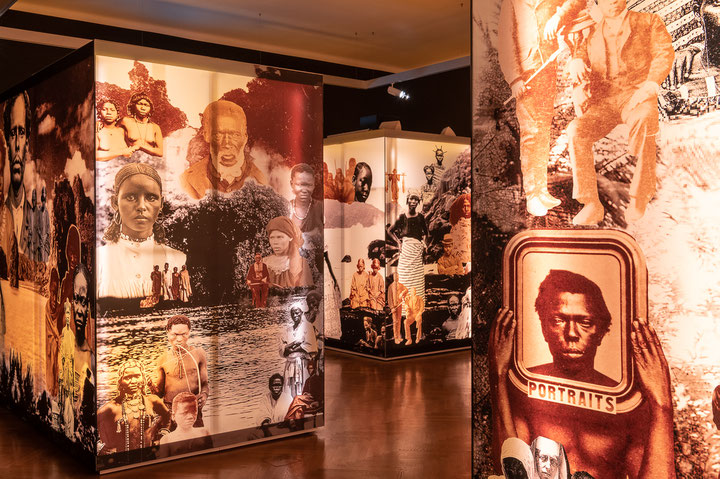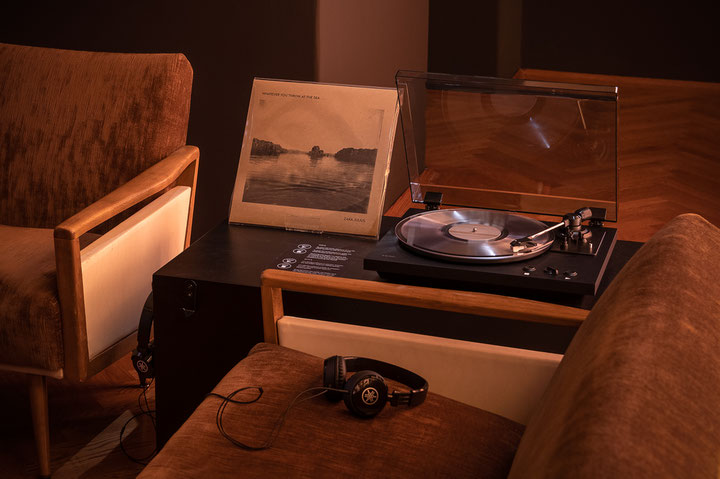Issue 2/2024 - Net section
Whatever You Throw at the Sea…
Fouad Asfour in conversation with interdisciplinary artist and researcher Zara Julius on the occasion of her exhibition at Weltmuseum Vienna
For her exhibition “Whatever You Throw at the Sea...”, Zara Julius collaged enlarged scans from the anthropological-ethnographic photo collection of the Weltmuseum Wien. The scans were put on transparent film and mounted on glass exhibition showcases. The sepia hue of historic photographs increased the haunted sense of the oversized neoclassicist building in which the museum is located. This was intensified by the endless band of empty landscape photographs that surrounded the installation, locating the viewer in the imagination of an “empty land”. Visitors found themselves navigating the labyrinth of ceiling-high lightboxes, passing first nation specters looking back at the colonizers’ and settlers’ photographic lenses at that moment – as if piercing time and space, moving from an unexpected future towards today’s intransigent past. Accompanied by sounds of the sea, breath, and a billowing bass, the exhibition activated the viewers’ senses in a movement similar to a dolly zoom, thus turning the installation into a kind of epistemological time machine. At the back end of the space, visitors found seats in front of a video of sepia waves projected on the wall between a set of open windows. Next to the sofas, the artist’s sound collages (pressed on vinyl records) could be listened to on headphones.
Fouad Asfour: My first thought when entering your installation “Whatever You Throw at the Sea...” was: Wow, Petina Gappah’s characters from the novel “Out of Darkness Shining Light” have come to haunt Austria’s imagined innocence of colonial crimes.1 How did you experience the process of selecting and collaging the historical photographs and recordings after your arrival there?
Zara Julius: Initially, I was curious about what it would mean to work with so-called “objects”. But it quickly became clear that this wasn’t possible; I was not willing to place objects behind glass cases, so I turned to the photographic collection. The trouble with the Weltmuseum database (and all ethnographic museum databases) is that the keywords and search terms are heavily informed by the curators who catalogued the material when it first arrived at the museum. At best, they’re unreliable, and they often involve significant racial slurs. So I went through each photograph in the database one by one, with no guiding hypothesis. Instead, I let material resonate on its own terms. I believe this is what Tina Campt means when she talks about “listening to images”: paying attention to the affective frequencies in an image. It’s these visual and sonic frequencies that guide my process. When I looked back at the selection I had made, it was these moments where the people being photographed are staring directly into the lens. Countering the ethnographic gaze. Saidiya Hartman refers to this as “the startle” in the archive: the moments where an image or recording stops you in your tracks. These confronting stares of the so-called “colonial subject” are not commonly displayed in the ethnological museum and it felt necessary to show these moments; that revolt and resistance to dispossession, to the colonial and missionary projects did happen! With both the selecting and assembling of historical photographs as well as recordings in the Phonogrammarchiv2, the process was really centered around affect and intuition – what Arthur Jafa calls “affective proximity”: the placing of media from different contexts alongside one another according to a logic outside of traditional linear timelines, attributions or a set of research questions.
Asfour: Could one say that you work against the normalized praxis of “curating” and instead make the material shout back in a rather performative way of refusal, claiming a certain opacity: “No, you guys don’t have the slightest idea”, leaving the viewer outside and disabling the carefully compliant, peaceful and happy representation of the “indigenous” person. Like saying, “you can’t know us, finish and klaar”?
Julius: In a sense, yes! Even if it’s not necessarily “finish ’n klaar”, then it’s certainly “You can’t know us, if these are the means you insist on using” – the means that insist on transparency and extraction, and hierarchy of knowledge and time, too. So the utterance is: until we’re ready to reorient our entire ways of not just knowing, but also ways of pursuing the claim to know, then yeah, there’s so much that’s being missed. And at this stage, this opacity is itself a victory in the face of the various unfreedoms we, and those whose faces, voices and songs live within these collections are experiencing. As both consequence of, and strategy towards/against/in the wake of…
This research and production process gets lifted in a way to allow for a necessary incoherence, I think. I’m not “encountering” the archive in order to bolster a preconceived argument or direction. The research process is also somewhat incoherent. I’m always trying to privilege the material and from there, pull on threads that slowly reveal themselves. Of course, this is a very time-consuming way to work, but I feel it’s the only honest way for me. I think it frustrates a particular kind of museum curator or collection manager because I’m often just like, “Can I see / listen to everything?” It caused some conflict in the museum initially. And I think this is a good thing. It’s a reminder that there are other ways in which things can be done that are also legitimate – and generative.
Asfour: It’s as if the acts of colonial violence are carried over through visual and sonic frequencies that you experienced – as if they refused the construction of “white” knowledges. How does your work expose these power relationships that are inherent in all our media?
Julius: Hmm, it’s about these more nuanced critiques of “encounter”; colonial and missionary encounter, encounter with the archive, and to borrow from Carine Zaayman, the process of “figuring the anarchive”. The original title of the show “Whatever you throw at the sea, the sea will throw it back” proposes an engagement with the “anarchive” as a means of escaping the constraints of archives; what you call “white knowledge”, and its empirical, visual, sonic, chronopolitical and museological grammars. And then, simultaneously, the work is also a reminder that there are many forms of knowledge-carrying and sharing that exist outside of these grammars and that require us to invest in a different sort of labor which starts from an understanding that knowledge creation isn’t unidirectional or teleological, but rather “tidalectic”. The seas and the land also bear witness, and they hold knowledge. So do the mbira and the sanza (musical instruments of which there are many in the museum’s collection), which trace histories and geographies across Africa and its multiple diasporas. In fact, the sanza you hear in the show is from the museum collection that I convinced the conservation team to let me play and record.
Ausfour: I felt that your work also disables the carefully edited invisibilities of the researcher/colonialist. Could one say that it also implicates how collections “work” to continue “settler futurities”, to speak with Eve Tuck?
Julius: I think many people who walk into ethnographic museums are still consuming the collections along the lines of “identity”, “belief” and “symbolism”. The curatorial vision of many of these museums is governed by a very narrow anthropological framework: “Here is this culture, juxtaposed with another. Now let’s compare and contrast how these cultures dress, honor their dead or adorn royalty.” These are actual threads in the permanent exhibition of the Weltmuseum. There’s an installation of American baseball hats “rivalling” an installation of Native American warbonnets, for example. [laughs]
I’m interested in what can happen when we get beyond the Black body as simply a signification of spectacle. Of course, I draw attention to this, but without making it exclusively about this… I do this not in a discursive way, but more in a haptic, embodied way that is situated inside the audience on an affective level. The audience becomes the spectacle in a way. And those faces in the collections, they’re the ones doing the looking. And this uncanny gaze, while a very simple device using scale and light, is not a very common experience for folks in that context who are otherwise invited to passively consume cultures from the majority world elsewhere in the museum. Of course, the show works precisely because it’s in a museum, and a historical building that signifies empire and transparency, enlightenment and of course, permanence – the idea that the ethnographic object ought to live forever and be preserved, at all costs, behind the glass vitrine. It’s exactly for this reason that I wrapped the permanent vitrines in the exhibition room and turned this central apparatus of the logic of permanence, and of the “Wunderkammer”3, on its head. Not to be looked into. But to do the looking.
Asfour: Which points to your sonic practice and your longtime collaboration with Tina Campt. Could sound turn the listener into a resonating board? What is the role of sound and listening in your work?
Julius: I mostly worked with audio material housed in the Phonogrammarchiv that was originally on magnetic tape, that then got digitized specifically for me so that I could work with it. I also made my own recordings, and after composing/assembling the work, I placed this material back on an analog 12-inch lathe-cut vinyl format as a sort-of “mixtape”. There’s no publicly available way to listen to the work in its entirety in digital format.4
It's also a very particular kind of process as the vinyl disintegrates the more you play it. The more you try to extract, the more you lose your grasp of it. It’s the same with the photographic material: digitized, assembled, and then placed onto large stickers that wrap the walls and the glass showcases, but that cannot be used again once it’s removed. To remove them is to destroy them. The exhibition, whilst it had a year-long run at the Weltmuseum, still resists permanence. In this sense, I think the question of mediation is absolutely essential.
An important aspect for me is that sound bypasses rational cognition and affects us on an embodied level. This is always a goal of mine, to get people to feel deeply, and to allow feeling to be a pathway to a certain kind of knowing. Sound creates a pathway to what I’ve been theorizing as “rapture” – a pathway to an elsewhere. A “petite-marronage”, if you will. Sound, even when listened to alone, generates a kind of sociality. Émile Durkeim writes about this as “collective effervescence”, but rapture is in excess of this. It means simultaneously being inside of one’s own body, and yet being in flight from the conditions under which the knowing, racialized body is usually rendered.
The context of the “Black Sonic” presents us with a set of possibilities through its centrality of polyvocality, polyrhythm, call and response, and atonality. These are devices that I draw on, regardless of the medium I’m working in. I think what’s central to my interest in sound, in line with this methodology of rapture, is the way sound offers us the possibility to reconstitute time. And more importantly, what Sylvia Wynter called “market time” – the chronopolitical order that renders the black body as a unit of labor at the mercy of missionary capitalist logics that assume fixity and a single voice of truth. Polyrhythms and polyvocality undo this, in the body through the production of sound. Sound carries this potential.
Whatever You Throw at the Sea… was on view at Weltmuseum Wien from 27th of April 2023 to 2nd of April 2024.
1 Find more information about the book here: https://www.simonandschuster.com/books/Out-of-Darkness-Shining-Light/Petina-Gappah/9781982110345
2 https://www.oeaw.ac.at/phonogrammarchiv/home
3 Read more about the “Wunderkammer” here: https://en.wikipedia.org/wiki/Cabinet_of_curiosities.
4 The vinyl release was a limited edition of 25, find extended liner notes here: http://www.zarajulius.com/whatever-you-throw

